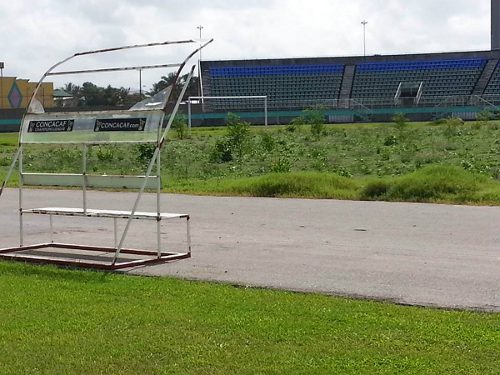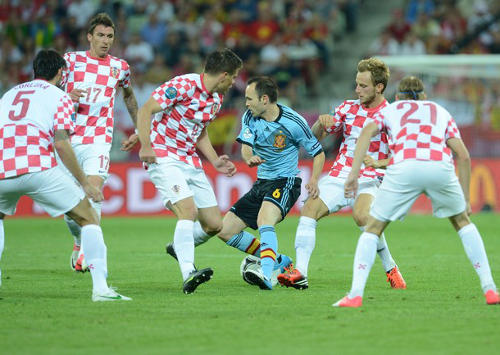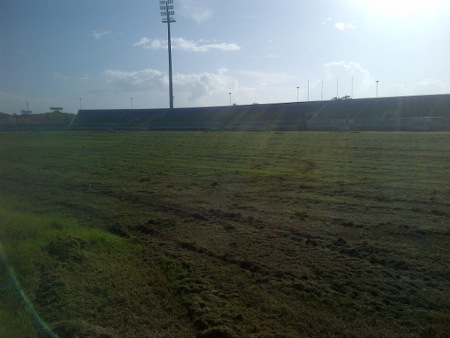The SPORTT Company of Trinidad and Tobago has moved to quell concerns over the state of the Mannie Ramjohn Stadium in Marabella after photographs were posted on Facebook and re-published on Wired868 of foot-high grass and watermelons at the State-owned sport facility.
Four of Trinidad and Tobago’s five State-owned stadia, the Mannie Ramjohn, Hasely Crawford, Larry Gomes and Dwight Yorke venues, were all closed earlier this year for refurbishment, which put a severe strain on sport enthusiasts and sporting bodies, including the Pro League.
But the Marabella stadium, which hosted the likes of Andrés Iniesta, Fernando Torres (both Spain), Carlos Tevez and Javier Mascherano (both Argentina) during the 2001 Under-17 World Championships, achieved a special notoriety after suggestions that it had bizarrely been converted into an agricultural space.

(Courtesy “Scoreboard Trinidad”)
Adrian Raymond, the SPORTT Company’s communications officer, insisted that the Sport Ministry had not neglected its facilities. He said that the Larry Gomes Stadium in Malabar is scheduled to be reopened tomorrow while the Hasely Crawford is days away from being ready too.
Refurbishment at the Mannie Ramjohn Stadium should start next week although Raymond did not offer a completion date. He explained that the rainy season might cause delays in the laying of a new athletic track.
“We will try to have it done as quickly as possible without comprising the quality of the work,” Raymond told Wired868. “Some of the work to be done is weather sensitive so we have to get around that. Ideally, you would want to have a lot of the work done in the dry season…”
So why was the work not done in the dry season, especially as the venue was closed since February?

Iniesta’s first major tournament was at the Trinidad and Tobago 2001 Under-17 World Cup where he played at the Mannie Ramjohn Stadium.
Anthony Blake, the SPORTT Company’s facility manager, explained that its contractors discovered design flaws in the drainage of the stadium, which has plagued the venue since its existence.
The underground pipes meant to handle run-off after downpours were, according to Blake, either not installed at all or faulty. And it meant that the stadium management frequently had to hire persons to use submersible pumps during important fixtures to prevent the ground from becoming waterlogged.
“There was no underground drainage at all around the perimeter of the field,” said Blake. “It was the same at the Larry Gomes Stadium. So we needed to have it redesigned.”
Blake estimated the cost of fixing the drainage at $1 million, which was done by German engineers. Then, there was sand imported from Guyana and Celebration Bermuda grass from Georgia.
The stadium, according to Blake, will be better than ever before. The football field should be ready in two and a half months although the completion of the track is harder to predict.
“When you are laying the track, you are essentially putting a rubber track on layer of glue on the asphalt,” said Blake. “If rain falls, whatever is put down and not dried must be thrown away. It doesn’t make sense to put down a track for a couple of million dollars and having it undermined like that…
“I would say the track should be completed by December at the latest. But, if there is good weather, then it can be done before.”
And what about the present condition of the Mannie Ramjohn?
The SPORTT Company provided photographs to Wired868, which showed the stadium in a much better light. Blake said he received those snaps on Wednesday when he called his staff in response to the Facebook images.

But did that really mean that the ground never hosted watermelons?
(Courtesy SPORTT)
However, a source who spoke on condition of anonymity told Wired868 that the field was cut within 48 hours of a visit from the Facebook poster. The anonymous poster alleged that an entrepreneurial stadium employee was responsible for the growth of watermelons on the football field.
Both Blake and Raymond doubted the authenticity of the Facebook photos, though.
“As far as I know, we never had a water melon patch on the field,” said Raymond. “There is no way that it would have happened on the inner field… I wonder about the validity of those photos. I have never seen the field like that.
“It would have to be that someone purposefully planted (the watermelons) on the field.”
Blake conceded that the grass had grown quite high but he said this was understandable considering the state of works and the cost of maintenance.
“It should be viewed in the context of a construction project site and not a field for play at this time,” said Blake. “It costs $50,000 a month to cut the grass and fertilise and so on. It didn’t make sense for us to pay that since no one can run or play football there because the track is up.”
Still, the SPORTT Company’s photographs suggested that someone did pay to have the grass cut recently. More relevant, according to SPORTT officials, is the beautiful future in store for the venue.

(Courtesy “Scoreboard Trinidad”)
The “Mannie melons”, presumably, will now be consigned to legend. And the Marabella stadium should soon be famous for sport once more.

Lasana Liburd is the managing director and chief editor at Wired868.com and a journalist with over 20 years experience at several Trinidad and Tobago and international publications including Play the Game, World Soccer, UK Guardian and the Trinidad Express.
 Wired868 Wired868 for smart sport news and opinion
Wired868 Wired868 for smart sport news and opinion







concerning melongate[crasher]…
the field had three watermelon vines growing, and yes, the melons in the pics did come from the field
however, the signage did say: construction, do not enter.
no one planted the melons, it’s more likely that the seeds were either thrown there by someone who ate melon while training, or by birds. (perhaps someone spat them out? hmmm…who we know in football that does spit plenty?)
but its humorous at the very least! LOL